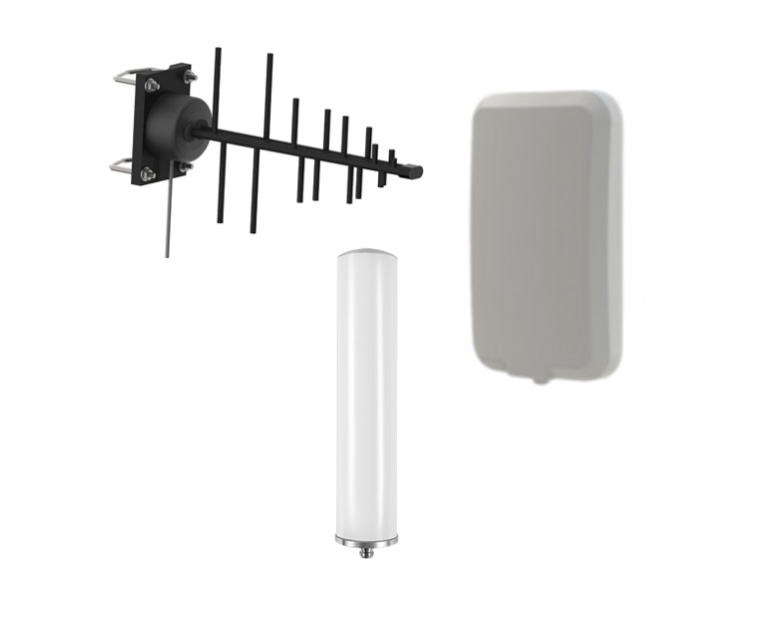
Table of Contents
Ensuring strong and reliable cellular signals in areas with poor coverage often requires a thoughtful solution. A repeater system is a key tool in this process, designed to capture, amplify, and redistribute cellular signals to improve connectivity. However, not all repeater setups are created equal, and the donor antenna plays a pivotal role in determining the system’s success. Selecting the right donor antenna goes beyond just looking for high gain—it involves understanding your environment, signal quality metrics, and potential interference sources. This guide will walk you through the essential considerations to help you make the best choice for your needs.
What is a Repeater System?
A repeater system, or cellular signal booster is a critical solution for improving cellular signal in areas with poor coverage. These systems will always include the following items:
- Donor Antenna: Generally installed outside a building or structure, this antenna receives cellular signals from the nearest cell tower.
- Repeater: Also called a signal booster or amplifier, this is the only piece that requires a power source. It amplifies the weak signal received by the donor antenna and rebroadcasts it through antennas located inside.
- Service/ Repeater Antenna: Takes the amplified signal and broadcasts it within the desired coverage area, ensuring improved reception indoors or in targeted locations.
Among these, the donor antenna is the cornerstone of the system. Selecting the right one ensures that the repeater receives the highest quality signal for amplification. Here’s how to choose an appropriate donor antenna and ensure optimal performance.
Directional vs. Omnidirectional Antennas
The choice between directional and omnidirectional antennas depends on your environment and needs. Let’s take a look at some factors to consider.
- Directional Antennas
- Designed to focus signal reception in one direction.
- Ideal for:
- Areas with a good line of sight to the cell tower.
- Situations where interference from other directions is high, as these antennas can be pointed away from sources of interference.
- Scenarios where you’re targeting a single carrier’s signal.
- Omnidirectional Antennas
- Capture signals from all directions.
- Best suited for:
- Environments with multiple cell towers or carriers.
- Locations with varying terrain, such as hills or valleys.
- Areas where line of sight to a specific tower is not feasible.
By understanding your coverage needs and surroundings, you can determine the most effective type of antenna for your repeater system.
Key Metrics: Gain, SINR, and RSRQ
While gain is often the first specification considered for antennas, other metrics like SINR and RSRQ are equally important.
Gain
Gain measures an antenna’s ability to amplify signal strength. A higher gain antenna captures and amplifies more signal, but it doesn’t necessarily improve communication quality if interference is present.
SINR (Signal-to-Interference-plus-Noise Ratio)
SINR evaluates the quality of the received signal by comparing it to the level of background interference and noise. It’s critical for ensuring clear and reliable communication. For example:
- < 13 dB: Poor quality, insufficient for effective signal boosting.
- 13 to 20 dB: Good quality, suitable for most needs.
- > 20 dB: Excellent quality, optimal for high-performance systems.
A high SINR ensures that the amplified signal remains clear, even after processing by the repeater.
RSRQ (Reference Signal Received Quality)
RSRQ provides another layer of insight into signal quality. It measures the ratio of signal strength to the total noise and interference within a given bandwidth. This metric complements SINR by giving an overall view of the cellular environment, especially in areas with fluctuating interference levels. A high RSRQ value indicates a stable and usable signal environment for amplification. For example:
- >= -10 dB: Strong signal with maximum data speeds.
- -10 dB to -15 dB: Strong signal with good to fair data speeds.
- –15 dB to -20 dB: Reliable data speeds may be hit or miss. The closer the value gets to -20, the weaker the performance and greater chance of disconnection.
Tips for Testing Locations for Your Donor Antenna
Selecting the right location for your donor antenna is as crucial as choosing the antenna itself. Follow these steps to maximize signal quality:
- Perform a Site Survey
- Use a cellular device or signal analyzer to identify areas with the strongest signal and minimal interference.
- Look for locations with a clear line of sight to the cell tower and minimal obstructions.
- Assess Interference
- Evaluate the SINR and RSRQ values to identify areas with the least noise and interference.
- If interference is detected from specific directions, consider a directional antenna and point it away from these sources.
- Minimize Cable Length
- Place the donor antenna as close as possible to the repeater to reduce signal loss in the coaxial cable.
- Account for Environmental Factors
- Avoid placing the antenna near metal structures or dense foliage, which can degrade signal quality.
Choosing an Antenna to Minimize Interference
In high-interference environments, selecting the right donor antenna can significantly improve performance. Look for the following features:
- Directional Antennas: As mentioned, these are effective for reducing interference by focusing on a single direction and avoiding noisy areas.
- Beamwidth: Narrow beamwidth antennas are particularly useful for filtering out signals from unwanted directions.
Balancing Performance and Practicality
While it’s tempting to focus on high gain, remember that signal quality (SINR and RSRQ) ultimately determines the success of your repeater system. Use the metrics from your site survey to make an informed decision and test different antenna types and placements as needed. To simplify this process, the 5Gstore Antenna Search Tool can be a valuable resource. This tool helps match antennas to your specific needs, taking into account your location, signal quality metrics, and coverage goals. By using this tool, you can explore options that best suit your environment and ensure optimal performance for your setup.

